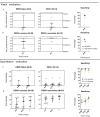Adapting Rapid Diagnostic Tests to Detect Historical Dengue Virus Infections
- PMID: 34367162
- PMCID: PMC8344047
- DOI: 10.3389/fimmu.2021.703887
Adapting Rapid Diagnostic Tests to Detect Historical Dengue Virus Infections
Abstract
The only licensed dengue vaccine, Dengvaxia®, increases risk of severe dengue when given to individuals without prior dengue virus (DENV) infection but is protective against future disease in those with prior DENV immunity. The World Health Organization has recommended using rapid diagnostic tests (RDT) to determine history of prior DENV infection and suitability for vaccination. Dengue experts recommend that these assays be highly specific (≥98%) to avoid erroneously vaccinating individuals without prior DENV infection, as well as be sensitive enough (≥95%) to detect individuals with a single prior DENV infection. We evaluated one existing and two newly developed anti-flavivirus RDTs using samples collected >6 months post-infection from individuals in non-endemic and DENV and ZIKV endemic areas. We first evaluated the IgG component of the SD BIOLINE Dengue IgG/IgM RDT, which was developed to assist in confirming acute/recent DENV infections (n=93 samples). When evaluated following the manufacturer's instructions, the SD BIOLINE Dengue RDT had 100% specificity for both non-endemic and endemic samples but low sensitivity for detecting DENV seropositivity (0% non-endemic, 41% endemic). Sensitivity increased (53% non-endemic, 98% endemic) when tests were allowed to run beyond manufacturer recommendations (0.5 up to 3 hours), but specificity decreased in endemic samples (36%). When tests were evaluated using a quantitative reader, optimal specificity could be achieved (≥98%) while still retaining sensitivity at earlier timepoints in non-endemic (44-88%) and endemic samples (31-55%). We next evaluated novel dengue and Zika RDTs developed by Excivion to detect prior DENV or ZIKV infections and reduce cross-flavivirus reactivity (n=207 samples). When evaluated visually, the Excivion Dengue RDT had sensitivity and specificity values of 79%, but when evaluated with a quantitative reader, optimal specificity could be achieved (≥98%) while still maintaining moderate sensitivity (48-75%). The Excivion Zika RDT had high specificity (>98%) and sensitivity (>93%) when evaluated quantitatively, suggesting it may be used alongside dengue RDTs to minimize misclassification due to cross-reactivity. Our findings demonstrate the potential of RDTs to be used for dengue pre-vaccination screening to reduce vaccine-induced priming for severe dengue and show how assay design adaptations as well quantitative evaluation can further improve RDTs for this purpose.
Keywords: Zika; dengue; dengue vaccine; pre-vaccination screening; rapid diagnostic test.
Copyright © 2021 Echegaray, Laing, Hernandez, Marquez, Harris, Laing, Chambers, McLennan, Sugiharto, Chen, Villagran, Collingwood, Montoya, Carrillo, Simons, Cooper, Lopez, Trueba, Eisenberg, Wu, Messer, Harris, Coloma and Katzelnick.
Conflict of interest statement
Authors PL and AH were employed by company Excivion Ltd. PL and AH hold stock in Excivion Ltd and via Excivion Ltd hold stock in Coronex Ltd, which companies own patent applications in RDTs and vaccines. ACh was employed by company Oxford Expression Technologies Ltd. NM was employed by company GlobalDX Ltd. IL has acted as a consultant for Excivion Ltd. The remaining authors declare that the research was conducted in the absence of any commercial or financial relationships that could be construed as a potential conflict of interest.
Figures






Similar articles
-
Evaluation of rapid diagnostic tests to detect dengue virus infections in Taiwan.PLoS One. 2020 Sep 29;15(9):e0239710. doi: 10.1371/journal.pone.0239710. eCollection 2020. PLoS One. 2020. PMID: 32991592 Free PMC article.
-
Assessment of diagnostic and analytic performance of the SD Bioline Dengue Duo test for dengue virus (DENV) infections in an endemic area (Savannakhet province, Lao People's Democratic Republic).PLoS One. 2020 Mar 17;15(3):e0230337. doi: 10.1371/journal.pone.0230337. eCollection 2020. PLoS One. 2020. PMID: 32182271 Free PMC article.
-
Evaluation of rapid diagnostic tests and conventional enzyme-linked immunosorbent assays to determine prior dengue infection.J Travel Med. 2019 Dec 23;26(8):taz078. doi: 10.1093/jtm/taz078. J Travel Med. 2019. PMID: 31616949
-
Rapid diagnostic tests for determining dengue serostatus: a systematic review and key informant interviews.Clin Microbiol Infect. 2019 Jun;25(6):659-666. doi: 10.1016/j.cmi.2019.01.002. Epub 2019 Jan 18. Clin Microbiol Infect. 2019. PMID: 30664935 Free PMC article.
-
Cross-Reactive T Cell Immunity to Dengue and Zika Viruses: New Insights Into Vaccine Development.Front Immunol. 2019 Jun 11;10:1316. doi: 10.3389/fimmu.2019.01316. eCollection 2019. Front Immunol. 2019. PMID: 31244855 Free PMC article. Review.
Cited by
-
Is new dengue vaccine efficacy data a relief or cause for concern?NPJ Vaccines. 2023 Apr 15;8(1):55. doi: 10.1038/s41541-023-00658-2. NPJ Vaccines. 2023. PMID: 37061527 Free PMC article. Review.
-
Componential usage patterns in dengue 4 viruses reveal their better evolutionary adaptation to humans.Front Microbiol. 2022 Sep 20;13:935678. doi: 10.3389/fmicb.2022.935678. eCollection 2022. Front Microbiol. 2022. PMID: 36204606 Free PMC article.
-
Comparison of the sensitivity and specificity of commercial anti-dengue virus IgG tests to identify persons eligible for dengue vaccination.J Clin Microbiol. 2024 Oct 16;62(10):e0059324. doi: 10.1128/jcm.00593-24. Epub 2024 Aug 28. J Clin Microbiol. 2024. PMID: 39194193 Free PMC article.
-
Validity of Self-Reported Mosquito Bites to Assess Household Mosquito Abundance in Six Communities of Esmeraldas Province, Ecuador.Am J Trop Med Hyg. 2023 Apr 10;108(5):981-986. doi: 10.4269/ajtmh.22-0371. Print 2023 May 3. Am J Trop Med Hyg. 2023. PMID: 37037437 Free PMC article.
-
Field evaluation of rapid diagnostic tests to determine dengue serostatus in Timor-Leste.PLoS Negl Trop Dis. 2022 Nov 7;16(11):e0010877. doi: 10.1371/journal.pntd.0010877. eCollection 2022 Nov. PLoS Negl Trop Dis. 2022. PMID: 36342959 Free PMC article.
References
-
- World Health Organization . Dengue Guidelines for Diagnosis, Treatment, Prevention and Control: New Edition. (Geneva, Switzerland: 2009), WHO/HTM/NTD/DEN/2009.1. - PubMed

